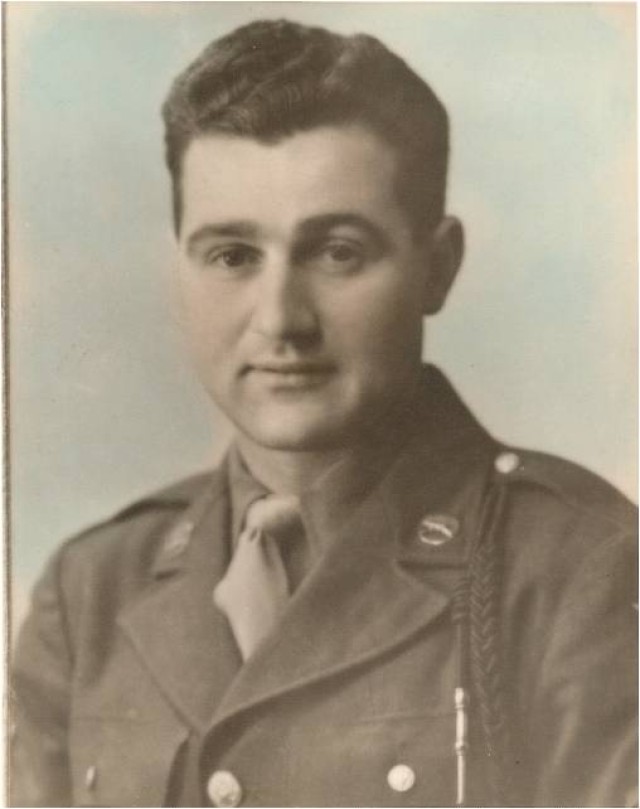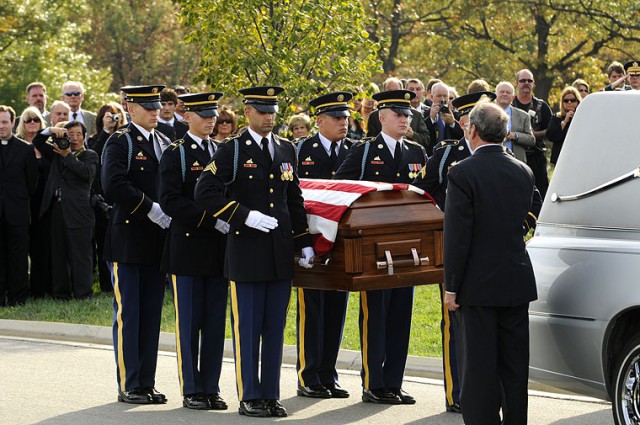WASHINGTON (Army News Service, Oct. 26, 2010) -- Just 10 days after the sand and blood of Normandy's beaches, on the heels of D-Day, 2nd Infantry Division Ranger Staff Sgt. John R. Simonetti lay prone in the hedgerows on the outskirts of the sleepy, deserted town of St. Germain d'Elle, zeroing in with his grenade launcher on a German machine-gun nest.
As the New Yorker sighted in on his target, a German sniper hidden in the town's church bell tower was squinting through his scope's cross-hairs on the 26-year old. Before the GI could pull off his round, the German squeezed off his.
Zzzzip... the bullet tore through Simonetti's throat, tumbling down, taking out a rib, lodging in his lower abdomen, killing him instantly. On the day Simonetti lost his life -- June 16, 1944 - more than a third of the remaining 300 men in his company would go down, and before the war ended, the 2nd Infantry Division would spend 337 days in action in five campaigns and loose 2,999 Soldiers.
The fighting was nothing short of brutal. Back and forth went the momentum, but eventually the American troops prevailed. Following what become known as the Battle of the Hedgerows and the capture of St. Germain d'Elle, the townspeople returned to what was left of their buildings and homes, the little church with the bell tower destroyed, the milk factory leveled.
Worse than the destruction of the village was the countless dead American and German Soldiers, lying in grotesque positions where they'd fallen, sometimes next to each other, victims of each other's weapons.
The town folk did what they could to bury the dead of both armies, making markers upon which dog tags hung, identifying who lay beneath the soil. Sometimes they buried the enemies together in the same hole. And, sometimes the markers got moved or the dog tags slipped off or were misplaced.
As the American Army pushed through St. Germain d'Elle and the rolling French countryside on the way to Berlin, they'd recover their dead, but sometimes the sons, fathers, husbands and uncles under the dirt weren't found. Unless an eyewitnesses could confirm they were killed, they were listed as missing in action.
That was the case of Italian-American Simonetti who grew up with seven brothers and sisters in Queens -- the offspring of immigrants who had come to the United States in steerage transiting through Ellis Island, home to Lady Liberty.
It would be 66 years before "Uncle John" was found and repatriated to the United States. With full military honors he was interred at Arlington National Cemetery Oct. 25, as 120 family members and their friends gathered round to bear witness to the legacy and homecoming.
Simonetti's Journey Home
Fred Salerno was just a year old when his Uncle John was killed, and while he doesn't remember sitting on his lap or the sound of his laugh, he does know that as he grew up, he felt as if he really knew the man, that he was bigger than life from the stories his grandmother would tell about her son year after year.
"There were 10 of us in the house - my grandmother and grandfather, great aunt, great uncle, my mom's sister, my parents and my two brothers," he recalled. "We were devout Catholics and had holy pictures throughout and next to the holy picture you always had your uncle. Every Friday we would all pray together and my grandmother would offer up the rosary to John. As kids, my brothers, Peter and Charlie and I were very impressed by this tragic thing that had occurred. We're praying for our uncle and that his soul goes to heaven, so those were the first memories I had of John, yet you have no future memories, but you also have no -- there was no closure."
Uncle John was always in the back of Salerno's mind.
As the 50th anniversary of D-Day neared, Salerno, then 52, reflected on how he could do honor to the memory of his uncle and all those who had died and lived through the fighting of World War II because "they were all heroes," he said. So, he and wife Pat traveled to France to pay homage. On June 6, 1994 they visited the American cemetery at Normandy.
"That just chokes you up, just being American... even if you never lost anybody, just to walk and look at the cemetery is a very emotional thing... the rows of crosses that are established... the symmetry... having read about the battle, it was a very emotional thing," he recalled.
Still, Salerno wanted to walk the "very hallowed grounds that he had walked, to try and get more closure," but no expectations beyond closure.
As luck would have it, he and Pat visited a local farmer and his wife in St. Germain d'Elle. The pair had been residents since before World War II had started.
"They couldn't have treated us any better," Salerno said. "The guy described the battle - we felt where we stood was where my uncle had been killed ... we could be that close to him. It was this psychic energy associated with just being there. It's unbelievable, chokes me up to think about it even today."
Before returning to the U.S., Salerno left his business card with the farmer with the idea that if he heard anything to let him know. The information on the card was accurate at the time.
"When we left, we felt very good. We brought pictures to the family; we described everything we saw... they all felt better about it," he remembered, but then the unbelievable intervened.
Just before Memorial Day 2009, Salerno received a call from a Bruce Biggs, a member of the Patriot Guard Riders, an organization of vets and non-vets, whose primary goal is to show respect for fallen heroes, their families and their communities.
"The only way I can describe this person is that he is an American patriot," Salerno said. "At first I didn't believe it... but the irony and improbability here is that the wife of the head of the province that includes St. Germain d'Elle is the sister of the wife of Bruce Biggs. Bruce had gone nuts trying to find me but nothing on my business card was current."
Finally... Closure
The real improbability and irony is that where Salerno had felt a connection with his Uncle John in 1994 in St. Germain d'Elle had been about 1,000 yards away from where 85 percent of a Soldier's remains lay less than three feet underground. Biggs had been relentless in trying to locate Salerno because two dog tags bearing his uncle's name had been located and while they weren't found in the same spot, they were not far from the remains that a construction crew had uncovered.
Biggs recommended Salerno call the Joint Prisoner of War/Missing in Action Accounting Command to follow up. The Army followed up and after Salerno had given his own DNA sample, the confirmation came back that the Soldier's remains were those of his Uncle John.
"I think the Army did a miraculous job. This speaks a lot to the value set that the Army has to repatriate one of its own after 66 years... there's no other country that does this," Salerno said, adding that the tribute and burial at Arlington National Cemetery was final closure for him and the entire family.
"Everybody involved took an extra step... the province officials, Bruce Biggs for no other reason than that he believes patriots should be honored, to the people of JPAC," Salerno said. "To have this happen and to think about all the things that could have gone wrong... the card could have been lost... if the construction crew hadn't dug for the community center... if all those things hadn't happened exactly the right way, we still wouldn't know where our uncle is."




Social Sharing